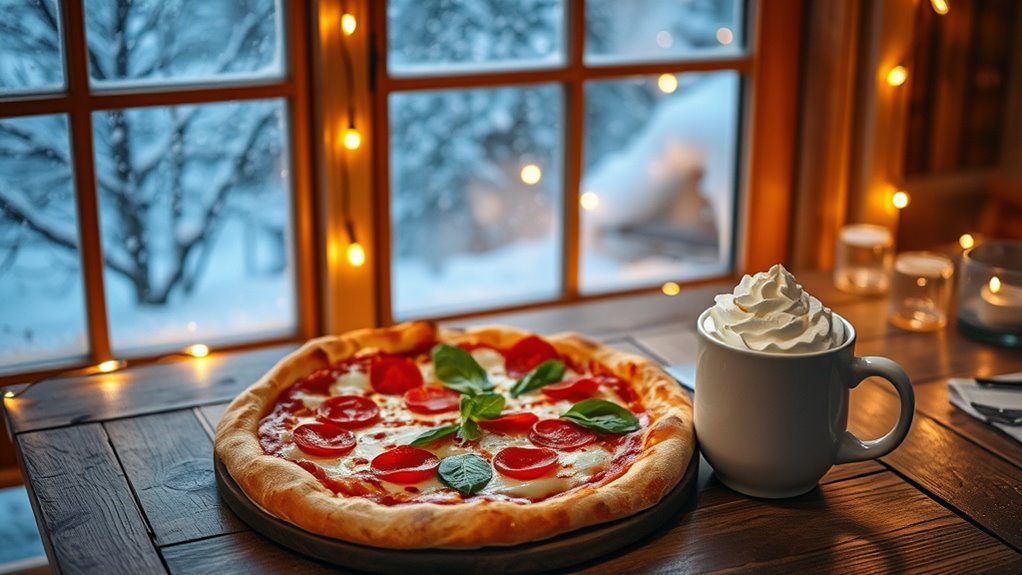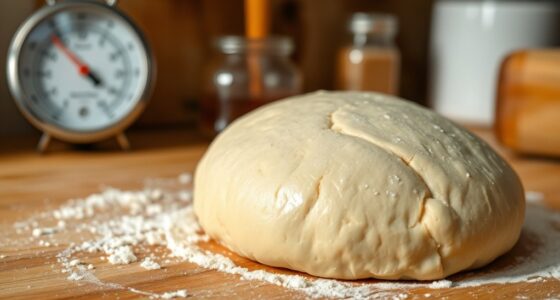For cozy winter pizza nights, opt for a hearty crust like a thick dough or crisp thin base, and preheat your oven with a pizza stone for perfect baking. Layer warming toppings such as roasted vegetables, spicy sausage, or rich cheeses, and finish with quality ingredients for the best flavor. Incorporate seasonal flavors like squash or cranberries, and pair your pizza with comforting sides and drinks. Keep exploring for more tips to elevate your winter pizza experience.
Key Takeaways
- Opt for a hearty, seasonal crust like thick dough or gluten-free options to evoke warmth and comfort.
- Use seasonal toppings such as roasted squash, cranberries, and caramelized onions for a cozy flavor profile.
- Incorporate rich cheeses and warming sauces like Alfredo or spicy barbecue to enhance the winter vibe.
- Pair your pizza with warm sides like roasted vegetables and beverages like mulled wine or hot cider.
- Prioritize high-quality, sustainable ingredients to elevate flavor and support eco-friendly practices during winter nights.
Choose the Right Crust for Comfort and Flavor

Choosing the right crust can make or break your winter pizza night. Proper dough storage is essential to keep your crust fresh and flavorful. Store your dough in an airtight container in the fridge, allowing it to develop a better texture and taste over time. When shaping your crust, consider how it will look and feel—good pizza presentation makes each slice more inviting. A thin, crispy crust offers a satisfying crunch, perfect for a cozy night, while a thicker, doughier base provides extra warmth and comfort. Remember, your choice of crust should complement your toppings and suit the mood of the evening. When done right, your crust can be the foundation of an unforgettable winter pizza experience.
Optimize Your Toppings for Warmth and Satisfaction

To make your winter pizza truly satisfying, focus on hearty, filling ingredients that warm you from the inside out. Incorporate flavors that evoke comfort, like roasted vegetables or savory meats, to boost that cozy feeling. Don’t forget to add nutrient-rich toppings to keep your meal both delicious and nourishing. Using whole foods as your base ingredients can enhance both the healthiness and flavor of your pizza.
Hearty, Filling Ingredients
During cold winter nights, hearty and filling toppings can transform your pizza into a comforting meal that warms you from the inside out. Focus on cheese varieties like ricotta, mozzarella, or sharp cheddar to add richness and substance. Combining different cheeses enhances flavor and creates a gooey, satisfying texture. For sauce options, opt for hearty choices like a robust marinara, creamy Alfredo, or even a spicy barbecue sauce to add depth and warmth. These toppings not only fill you up but also bring a satisfying richness that’s perfect for winter. Don’t be afraid to layer ingredients like sausage, roasted veggies, or even bacon to boost caloric content and flavor. The right combination guarantees your pizza is both nourishing and indulgent.
Warm, Comforting Flavors
When aiming for warm, comforting flavors on your winter pizza, focus on toppings that evoke coziness and satisfaction. Rich cheeses, caramelized onions, and roasted vegetables create a hearty, inviting profile. For gluten-free options, try adding smoky bacon, sautéed mushrooms, or spicy sausage. Vegan toppings can include roasted butternut squash, marinated tofu, or spinach with garlic. Use the table below to inspire your topping choices:
| Classic Comforts | Vegan Options | Gluten-Free Alternatives |
|---|---|---|
| Mozzarella & Parmesan | Roasted butternut squash | Sliced grilled chicken |
| Caramelized onions | Marinated tofu | Crispy bacon bits |
| Sausage | Sautéed mushrooms | Spicy sausage |
Choose toppings that warm the soul and satisfy your cravings—winter’s the perfect time for cozy flavors. Incorporating rustic decor elements into your kitchen or dining area can enhance the overall cozy vibe of your winter pizza nights.
Nutrient-Rich Toppings
Adding nutrient-rich ingredients to your winter pizza boosts both its health benefits and its comforting flavors. When choosing toppings, consider the pros and cons of store-bought versus homemade options. Store-bought toppings are convenient and often pre-washed, but they may contain preservatives or added sodium. Homemade toppings give you control over ingredients, allowing you to customize for maximum nutrition. For vegan and gluten-free choices, options like sautéed spinach, roasted sweet potatoes, or marinated mushrooms add vitamins and fiber without sacrificing flavor. These toppings can also cater to dietary restrictions, making your pizza inclusive and wholesome. Incorporating a variety of vegetables, legumes, and plant-based proteins enriches your pizza’s nutrient profile, ensuring it’s satisfying and nourishing during those chilly winter nights. Dog breeds are diverse, and selecting the right toppings can reflect your pet’s unique traits or preferences, enhancing your cozy meal experience.
Master the Art of Baking for a Crispy Finish

To get that perfect crispy finish, you need to focus on your dough’s texture and your baking method. Pay attention to how you handle the dough to guarantee it’s just the right consistency. When it’s time to bake, using the right temperature and technique will give you that satisfying crunch you crave. Incorporating attention into your process can significantly enhance your results.
Perfecting Dough Texture
Achieving the perfect dough texture is key to a crispy, flavorful pizza crust. To do this, focus on gluten development, which creates structure and elasticity. Use proper fermentation techniques—allowing the dough to rest and rise slowly—to enhance flavor and texture. Hand-kneading or minimal mixing can prevent overworking the gluten, keeping the crust tender yet sturdy. The table below highlights essential factors:
| Technique | Effect on Dough | Tips |
|---|---|---|
| Proper gluten development | Improves elasticity and chew | Knead until dough is smooth but not overworked |
| Fermentation duration | Enhances flavor and texture | Let dough rise at least 1-2 hours or overnight |
| Temperature control | Affects yeast activity | Keep dough in a warm, draft-free area |
Developing mental awareness of how these factors interact can further improve your baking process. Mastering these techniques guarantees a dough with the right texture for a crispy, satisfying pizza.
Achieving Crisp Crust
For a truly crispy pizza crust, mastering the baking process is essential. To achieve that perfect crunch, focus on these tips:
- Preheat your oven thoroughly, ideally to 500°F or higher, to ensure even heat distribution.
- Use a pizza stone or steel to mimic a professional oven’s heat, giving your crust a crisp exterior.
- For gluten-free crusts, avoid excess moisture and bake longer to prevent sogginess.
- Keep an eye on bake time; vegan cheese options melt quickly, so add them later to avoid sogginess.
- Consider finishing your pizza with a brief broil to enhance crispness and add a slight char.
- Additionally, understanding the importance of contrast ratio can help you assess your oven’s ability to produce deep blacks and bright whites, which is crucial if you want to visually gauge the crispiness and overall quality of your baked pizza.
Use Quality Ingredients to Elevate Every Slice
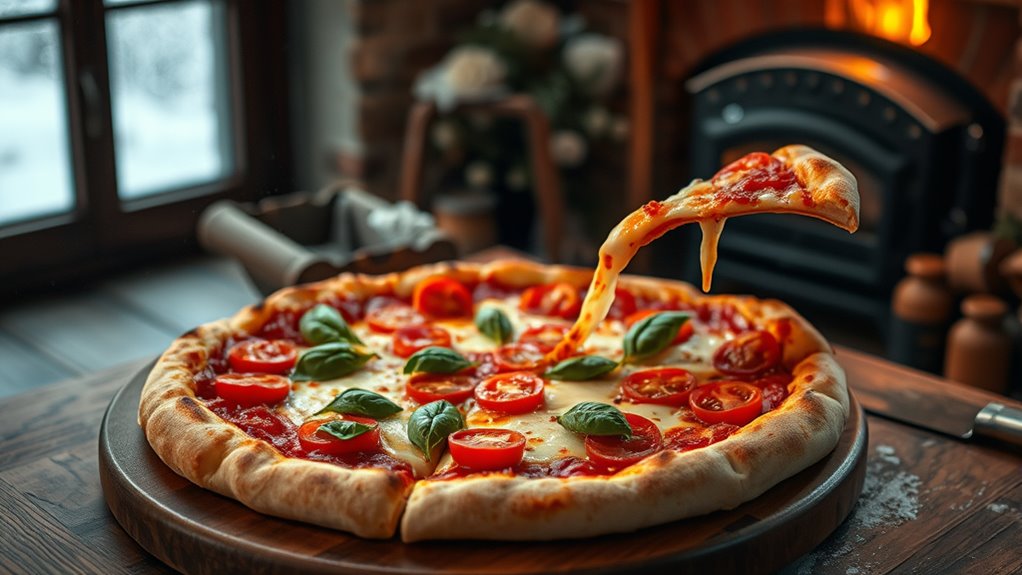
Using high-quality ingredients makes a noticeable difference in every pizza slice you create. When choosing toppings, opt for fresh produce over frozen, as fresh ingredients deliver brighter flavors and better texture. For cheese, selecting high-quality, authentic varieties enhances richness and melts more smoothly. When comparing store-bought versus homemade sauce, homemade often offers superior flavor and control over ingredients, making your pizza more memorable. Don’t settle for cheap, processed options; instead, invest in quality meats, cheeses, and vegetables. These small but impactful choices elevate your pizza’s taste and presentation. Additionally, paying attention to marine conservation practices can inspire more sustainable ingredient choices and ensure the health of marine ecosystems. Remember, the better your ingredients, the more your pizza stands out—delivering a truly delicious winter pizza night every time.
Incorporate Seasonal Flavors for a Cozy Twist
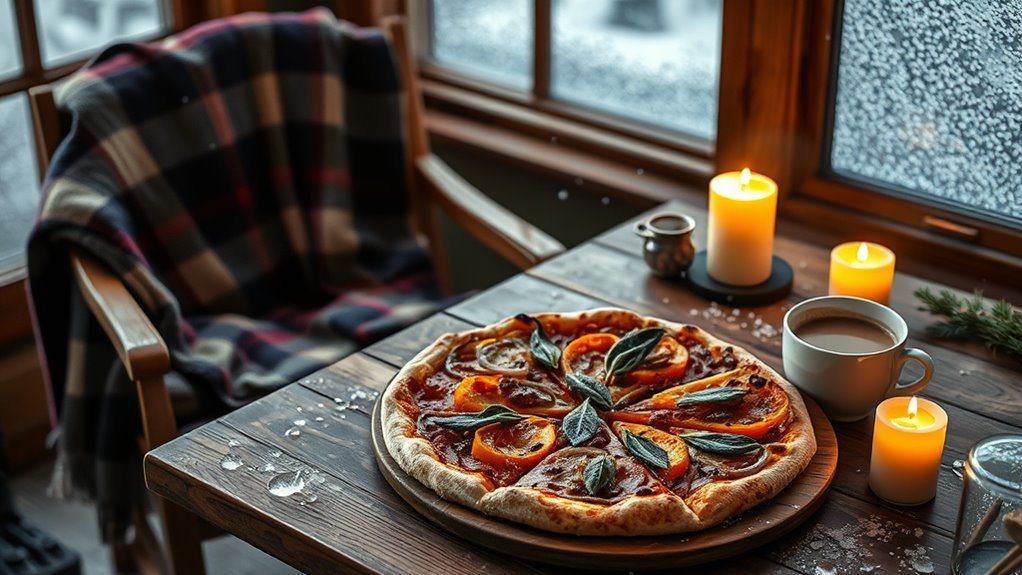
As winter settles in, incorporating seasonal flavors into your pizza not only adds a cozy touch but also enhances its overall warmth and comfort. Embrace ingredients that evoke the season’s spirit and create a memorable meal. Try drizzling ginger infused sauces for a spicy kick that warms from the inside out. Add toppings like roasted butternut squash, caramelized onions, or cranberries for a burst of seasonal flair. Finish your pizza with a sprinkle of cinnamon or nutmeg to subtly evoke those cinnamon spiced desserts you crave in winter. You can also incorporate hearty greens like kale or sage for added depth. Utilizing personality insights can help tailor your flavor combinations to suit different tastes and preferences, making your winter pizza nights even more enjoyable. These flavors make your pizza truly festive and inviting, perfect for chilly nights. Remember, balancing spice with sweetness keeps the flavor profile cozy and satisfying.
Pair Your Pizza With Perfect Winter Sides
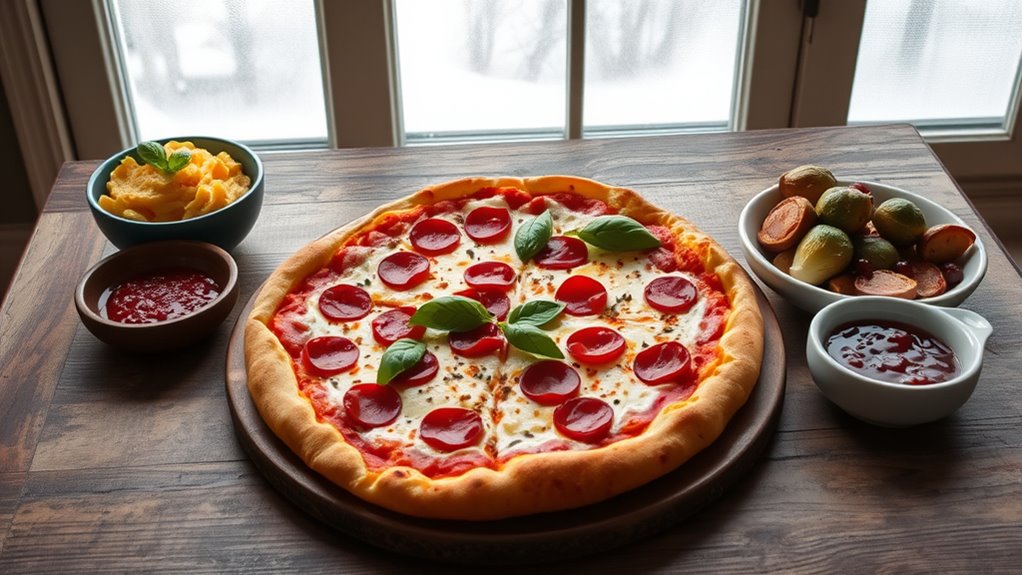
To enhance your winter pizza nights, pairing your slices with the right sides can create a warm, satisfying meal. Consider adding cozy dessert pairings like cinnamon-spiced cookies or warm apple crisp to finish on a sweet note. For beverage options, opt for hearty choices such as mulled wine, hot cider, or rich craft beers to complement the flavors of your pizza. Steamed or roasted vegetables like Brussels sprouts or butternut squash also work well as sides, adding warmth and nutrition. These pairings not only elevate your meal but also help create a comforting winter atmosphere. Focus on flavors that are hearty and warming to make your pizza night truly special and satisfying amid the cold season. Incorporating cost-effective strategies for asset division can help ensure your overall financial health is maintained during the winter months.
Frequently Asked Questions
What Are Some Gluten-Free Crust Options for Winter Pizza Nights?
You can try gluten-free crusts like cauliflower, chickpea, or almond flour-based winter pizza bases. These options are healthy and flavorful, perfect for cozy winter nights. Cauliflower crust offers a crispy texture, while chickpea provides a hearty taste. Almond flour bases add a nutty flavor. Experiment with different gluten-free crusts to find your favorite, making your winter pizza nights enjoyable and inclusive for everyone.
How Can I Make Vegan Toppings That Still Feel Hearty?
To make vegan toppings that feel hearty, you should include plant-based proteins like tempeh, tofu, or chickpeas, which add substantial flavor and texture. Load up on hearty vegetables such as mushrooms, bell peppers, and spinach for added bulk. Season generously with herbs and spices, and consider drizzling a flavorful vegan sauce or nutritional yeast to enhance richness. This combo creates a satisfying, nourishing pizza that truly feels indulgent.
Which Cheeses Melt Best for a Gooey Winter Pizza?
You should go with mozzarella for the best melt, as it creates that gooey, stretchy texture perfect for winter pizzas. Use cheese melting techniques like shredding it thin and adding it evenly to guarantee smooth coverage. While cheddar melts well, it tends to be less stretchy and can become greasy. For a gooey, satisfying result, mozzarella is your top choice, especially when you want that classic pizza melt.
How Do I Store Leftover Pizza Without Losing Flavor?
Want your leftover pizza to stay flavorful? Here’s the secret: wrap it tightly in foil before storing. When reheating, foil helps trap moisture and prevents flavor from escaping. Keep it in an airtight container if possible, and reheat gently to preserve its delicious taste. Don’t leave it out or forget the foil—missed steps could ruin that perfect slice. Follow this, and your pizza stays just as tasty as when first made.
What Are Creative Non-Traditional Sauces to Try This Season?
You should try creative non-traditional sauces like pesto, honey mustard, or even hummus for your pizza. These sauces offer unique sauce pairing options that elevate your flavor experimentation. They bring unexpected depth and richness to your pizza, making each bite exciting. Don’t be afraid to mix and match flavors—adding a drizzle of balsamic glaze or a splash of hot sauce can transform your winter pizza nights into a culinary adventure.
Conclusion
So, why settle for ordinary when you can make winter pizza nights truly special? By choosing the right crust, toppings, and seasonal flavors, you’re creating more than just a meal—you’re crafting cozy memories. With a little effort, every slice becomes a warm hug on a cold night. Are you ready to turn your pizza game up a notch and embrace the comfort of homemade, season-inspired flavors? Your perfect winter pizza awaits—go ahead, make it unforgettable.
